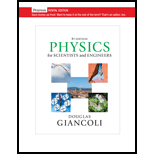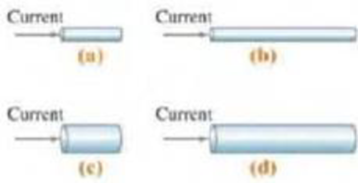
PHYSICS F/SCI.+ENGR.,CHAPTERS 1-37
5th Edition
ISBN: 9780134378060
Author: GIANCOLI
Publisher: RENT PEARS
expand_more
expand_more
format_list_bulleted
Textbook Question
Chapter 25.3, Problem 1CE
Return to the Chapter-Opening Question, page 651, and answer it again now. Try to explain why you may have answered differently the first time.
CHAPTER-OPENING QUESTION–Guess now!
The conductors shown are all made of copper and are at the same temperature. Which conductors would have the greatest resistence to the flow of charge entering from the left? Which would offer the least resistence?

Expert Solution & Answer
Want to see the full answer?
Check out a sample textbook solution
Students have asked these similar questions
Deduce what overvoltage is like in reversible electrodes.
pls help on these
pls help on these
Chapter 25 Solutions
PHYSICS F/SCI.+ENGR.,CHAPTERS 1-37
Ch. 25.2 - If 1 million electrons per second pass a point in...Ch. 25.2 - Prob. 1BECh. 25.3 - Return to the Chapter-Opening Question, page 651,...Ch. 25.4 - Prob. 1DECh. 25.4 - Prob. 1EECh. 25.4 - Prob. 1FECh. 25.4 - How many 60-W 120-V lightbulbs can operate on a...Ch. 25.6 - Each channel of a stereo receiver is capable of an...Ch. 25 - What quantity is measured by a battery rating...Ch. 25 - When an electric cell is connected to a circuit,...
Ch. 25 - When a flashlight is operated, what is being used...Ch. 25 - One terminal of a car battery is said to be...Ch. 25 - When you turn on a water faucet, the water usually...Ch. 25 - Can a copper wire and an aluminum wire of the same...Ch. 25 - The equation P = V2/R indicates that the power...Ch. 25 - What happens when a lightbulb burns out?Ch. 25 - If the resistance of a small immersion heater (to...Ch. 25 - Prob. 10QCh. 25 - Explain why lightbulbs almost always burn out just...Ch. 25 - Which draws more current, a 100-W lightbulb or a...Ch. 25 - Electric power is transferred over large distances...Ch. 25 - A 15-A fuse blows repeatedly. Why is it dangerous...Ch. 25 - When electric lights are operated on low-frequency...Ch. 25 - Driven by ac power, the same electrons pass back...Ch. 25 - The heating element in a toaster is made of...Ch. 25 - Is current used up in a resistor? Explain.Ch. 25 - Compare the drift velocities and electric currents...Ch. 25 - A voltage V is connected across a wire of length l...Ch. 25 - Why is it more dangerous to turn on an electric...Ch. 25 - Prob. 1PCh. 25 - Prob. 2PCh. 25 - Prob. 3PCh. 25 - Prob. 4PCh. 25 - Prob. 5PCh. 25 - Prob. 6PCh. 25 - Prob. 7PCh. 25 - Prob. 8PCh. 25 - Prob. 9PCh. 25 - Prob. 10PCh. 25 - Prob. 11PCh. 25 - Prob. 12PCh. 25 - Prob. 13PCh. 25 - Prob. 14PCh. 25 - Prob. 15PCh. 25 - (II) A rectangular solid made of carbon has sides...Ch. 25 - (III) A hollow cylindrical resistor with inner...Ch. 25 - Prob. 63GP
Additional Science Textbook Solutions
Find more solutions based on key concepts
Why is living epithelial tissue limited to a certain thickness?
Human Anatomy & Physiology (2nd Edition)
Police Captain Jeffers has suffered a myocardial infarction. a. Explain to his (nonmedically oriented) family w...
Human Physiology: An Integrated Approach (8th Edition)
Plants use the process of photosynthesis to convert the energy in sunlight to chemical energy in the form of su...
Campbell Essential Biology (7th Edition)
Which elements would you expect to lose electrons in chemical changes? a. potassium b. sulfur c. fluorine d. ba...
Introductory Chemistry (6th Edition)
Modified True/False 6. __________ Halophiles inhabit extremely saline habitats, such as the Great Salt Lake.
Microbiology with Diseases by Body System (5th Edition)
Two culture media were inoculated with four different bacteria. After incubation, the following results were ob...
Microbiology: An Introduction
Knowledge Booster
Learn more about
Need a deep-dive on the concept behind this application? Look no further. Learn more about this topic, physics and related others by exploring similar questions and additional content below.Similar questions
- 20. Two small conducting spheres are placed on top of insulating pads. The 3.7 × 10-10 C sphere is fixed whie the 3.0 × 107 C sphere, initially at rest, is free to move. The mass of each sphere is 0.09 kg. If the spheres are initially 0.10 m apart, how fast will the sphere be moving when they are 1.5 m apart?arrow_forwardpls help on allarrow_forwardpls help on thesearrow_forward
- pls help on all asked questions kindlyarrow_forwardpls help on all asked questions kindlyarrow_forward19. Mount Everest, Earth's highest mountain above sea level, has a peak of 8849 m above sea level. Assume that sea level defines the height of Earth's surface. (re = 6.38 × 106 m, ME = 5.98 × 1024 kg, G = 6.67 × 10 -11 Nm²/kg²) a. Calculate the strength of Earth's gravitational field at a point at the peak of Mount Everest. b. What is the ratio of the strength of Earth's gravitational field at a point 644416m below the surface of the Earth to a point at the top of Mount Everest? C. A tourist watching the sunrise on top of Mount Everest observes a satellite orbiting Earth at an altitude 3580 km above his position. Determine the speed of the satellite.arrow_forward
- pls help on allarrow_forwardpls help on allarrow_forward6. As the distance between two charges decreases, the magnitude of the electric potential energy of the two-charge system: a) Always increases b) Always decreases c) Increases if the charges have the same sign, decreases if they have the opposite signs d) Increases if the charges have the opposite sign, decreases if they have the same sign 7. To analyze the motion of an elastic collision between two charged particles we use conservation of & a) Energy, Velocity b) Momentum, Force c) Mass, Momentum d) Energy, Momentum e) Kinetic Energy, Potential Energyarrow_forward
- pls help on all asked questions kindlyarrow_forwardpls help on all asked questions kindlyarrow_forward17. Two charges, one of charge +2.5 × 10-5 C and the other of charge +3.7 × 10-6 C, are 25.0 cm apart. The +2.5 × 10−5 C charge is to the left of the +3.7 × 10−6 C charge. a. Draw a diagram showing the point charges and label a point Y that is 20.0 cm to the left of the +3.7 × 10-6 C charge, on the line connecting the charges. (Field lines do not need to be drawn.) b. Calculate the net electric field at point Y.arrow_forward
arrow_back_ios
SEE MORE QUESTIONS
arrow_forward_ios
Recommended textbooks for you
 University Physics Volume 1PhysicsISBN:9781938168277Author:William Moebs, Samuel J. Ling, Jeff SannyPublisher:OpenStax - Rice University
University Physics Volume 1PhysicsISBN:9781938168277Author:William Moebs, Samuel J. Ling, Jeff SannyPublisher:OpenStax - Rice University

 Physics for Scientists and Engineers: Foundations...PhysicsISBN:9781133939146Author:Katz, Debora M.Publisher:Cengage Learning
Physics for Scientists and Engineers: Foundations...PhysicsISBN:9781133939146Author:Katz, Debora M.Publisher:Cengage Learning Glencoe Physics: Principles and Problems, Student...PhysicsISBN:9780078807213Author:Paul W. ZitzewitzPublisher:Glencoe/McGraw-Hill
Glencoe Physics: Principles and Problems, Student...PhysicsISBN:9780078807213Author:Paul W. ZitzewitzPublisher:Glencoe/McGraw-Hill College PhysicsPhysicsISBN:9781938168000Author:Paul Peter Urone, Roger HinrichsPublisher:OpenStax College
College PhysicsPhysicsISBN:9781938168000Author:Paul Peter Urone, Roger HinrichsPublisher:OpenStax College

University Physics Volume 1
Physics
ISBN:9781938168277
Author:William Moebs, Samuel J. Ling, Jeff Sanny
Publisher:OpenStax - Rice University



Physics for Scientists and Engineers: Foundations...
Physics
ISBN:9781133939146
Author:Katz, Debora M.
Publisher:Cengage Learning

Glencoe Physics: Principles and Problems, Student...
Physics
ISBN:9780078807213
Author:Paul W. Zitzewitz
Publisher:Glencoe/McGraw-Hill

College Physics
Physics
ISBN:9781938168000
Author:Paul Peter Urone, Roger Hinrichs
Publisher:OpenStax College
Series & Parallel - Potential Divider Circuits - GCSE & A-level Physics; Author: Science Shorts;https://www.youtube.com/watch?v=vf8HVTVvsdw;License: Standard YouTube License, CC-BY